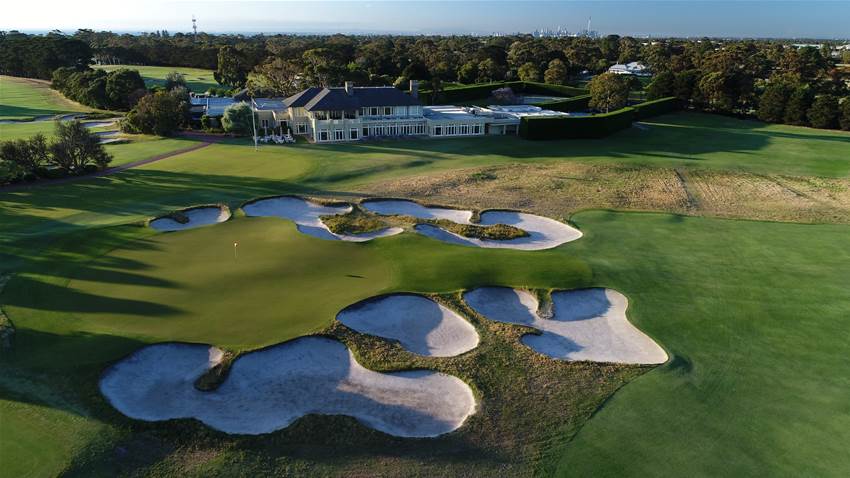First things first. When my fellow Golf Australia columnist, Mike Clayton, mentioned to me that we should try to set up what has since become the ‘Sandbelt Invitational’, we were both aware that this was not a new idea.
Many times over the years people have talked hypothetically about how great it would be to have a 72-hole event played on four of Melbourne’s world-famous courses.
Which is not to say that Mike was not the catalyst this time round. He was the one who made the initial calls to Royal Melbourne, Yarra Yarra, Kingston Heath and Peninsula Kingswood. He was the instigator. So, he deserves a lot of any credit going for that, as do the clubs for their positive reactions to what we are trying to do.
The motivation for the tournament was shared though.
Like everyone else in Australia, Mike and I were getting a bit disillusioned by the number of tournaments disappearing from the schedule because of the on-going COVID-19 pandemic. We had been able to host some small events and so create a pretty good little community of players, both professional and amateur, which was fine. But we wanted to do more.
This time – the event starts Monday – we will have a field of 60 players, made up of the best pros and amateurs we can find. We felt that number was enough, given that Melbourne has been locked down so much over the past 18 months or so. We didn’t want to encroach too much on members finally getting to play their courses. For that reason, a “traditional” 72-hole event at one course wasn’t really “on”. So, we thought asking for 20 tee-times at each venue was reasonable and fair. And they all said “yes”.

I mentioned how Mike and I had started organising one-day events that came to be called “the game”. It was apparent to me when I moved back to Australia from the United States that the elite kids in the high-performance programs weren’t playing enough competitive golf. They had been turned into a sort of sports science experiment. Their focus was on physical preparation and technique, which made them really good golfers. They were getting the “pieces” right, but the intangibles were missing.
If I can digress for a minute, the current generation is way ahead of my own physically. It is unbelievable how good many of them are. But they don’t know how to really play golf. In America it is very different. Over there, they have what might be called a “wagering culture”. Our way is to play 18-holes and return your card, which is fine. But you are always playing against your handicap.
"We’ve gone down the road of thinking we need to run really big events with one or two star names, all paid for by government. Instead, we should be running fundamentally good tournaments on great courses and see what happens." - Geoff Ogilvy.
What is missing – especially for the really promising players – is just getting out there and playing against people who are as good as they are, or even better. That’s so much more productive than standing on a range trying to make a perfect swing. But that’s where I saw many of our best youngsters – they just weren’t playing enough golf. As a result, many of the little events I used to play in as an amateur have disappeared. Just about every club had an open event. But they just don’t happen anymore.
Anyway, that was the original motivation behind what has so far evolved into the Sandbelt Invitational.
There was a selfish aspect to it all too. I wanted to compete rather than camp on the range hitting balls. It was “let’s put down $20 and go play”. Which was difficult when we were trying to do it all unofficially. Those keen to play were members all over the place at different clubs. So, getting everyone together at just one wasn’t easy.
RELATED: Sandbelt Invitational preview
Which was how “the game” came to be. We called round and asked clubs if we could have a few tee-times so that our mixture could play. We’ve had experienced pros like myself, Marcus Fraser, Nick O’Hern and Matt Griffin. Then there were guys like Zach Murray and David Micheluzzi. And a bunch of kids, basically anyone with aspirations to play pro golf. There was a bit of mentoring going on amidst the friendly competition. It was “real” golf, with benefits for all concerned.
It has been interesting.
Growing up I always felt like I learned more just by playing with really good players and listening to what they said. Being around them gave me the best lessons I could have got. Looking back, I was a sponge, soaking up valuable information that made me a better player quicker than I would have otherwise.
Think of it this way. When you first get your driving licence you think you’re a good driver. But with every year that passes you get better still. With more and more experience, you get a feel for it. You anticipate when things are going to happen. And that’s what was missing in so many of the young Aussie amateurs I’ve seen. They didn’t handle too well the little moments of stress you get in every round. They lacked the “in-between” stuff you need to score really well. Not because they couldn’t do any of those things; only because they hadn’t done them enough.
"No, the prizemoney won’t be huge. But four consecutive days playing four of the best courses on the Sandbelt sounds pretty good to me."
Apart from anything else, of course, playing with guys who are at least as good as you are and oftentimes better, is just more fun. There’s a bit of banter going on. There’s a bit of showing-off with certain shots. That’s why you play golf and want to be good. It’s a culture thing. And that’s how our little community came to be and grew to the point where we were often over-subscribed, which is, again, how the Sandbelt Invitational came to be. It grew out of the spirit of what we are trying to do with “the game”.
Another benefit: with this event we will be highlighting and showcasing the Melbourne Sandbelt, something we haven’t really done for the last 20 years. We’ve had the Presidents Cup, but the Australian Tour is not what it was, so we haven’t been utilising our assets as much as we should. We’ve gone down the road of thinking we need to run really big events with one or two star names, all paid for by government. Instead, we should be running fundamentally good tournaments on great courses and see what happens. Trying to keep up with the golfing Joneses got us on the wrong track.
All of which is a roundabout way of explaining how the Sandbelt Invitational came to be. In essence it is a bigger and bolder version of the game. We’ll have the best male and female pros we can find, balanced by the presence of the best up-and-coming amateurs. This year, it will be a pretty small affair. There won’t be any practice rounds, for example. I can see it growing over time.
I’d love to see this thing evolve into a full-field event, with a similar format. Maybe it becomes something similar – but without the pro-am element – to the AT&T in California or the Dunhill Links Championship in Scotland. Those events use only three courses, with everyone gathering at just one for the final round. And maybe we eventually get a date when our top players – Hannah Green, Cam Smith, Marc Leishman and Adam Scott – are home and can play.
But this is just the start. And the signs are good. There are a couple of exemptions available, into the Australian PGA and the Vic Open. No, the prizemoney won’t be huge. But four consecutive days playing four of the best courses on the Sandbelt sounds pretty good to me.
Related Articles

Under the radar into contention: Si Woo’s scintillating Australian Open Saturday

Column: The Sandbelt never lies













